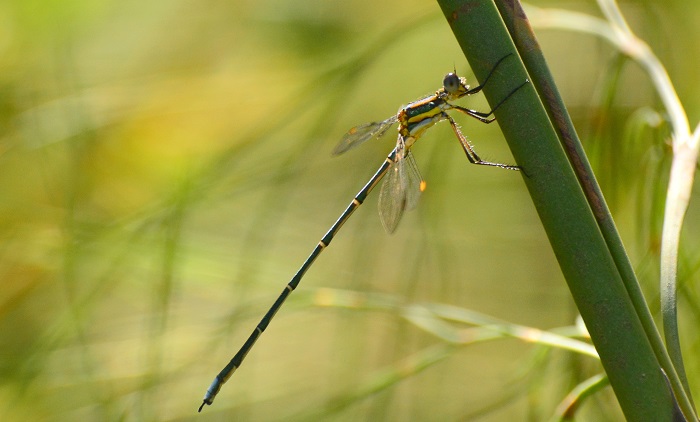Cover photo by Gregg Darling.
Find the Conspicuous Malachite in the FBIS database (Freshwater Biodiversity Information System) here.
Family Synlestidae
Identification

Kareedouw Mountain, Eastern Cape
Photo by Jorrie Jordaan
Large size
Length up to 65mm; Wingspan reaches 73mm.
The Conspicuous Malachite is largest species in its genus. It is a fairly dull coloured species but the thorax stripes are relatively broad, bright and noticeable. The thorax and abdomen are metallic-green aging to coppery brown. Males never develop black-banded wings.
The most diagnostic features of the Conspicuous Malachite are the large size, long brownish pterostigmas (not bi-coloured), and the bright yellow lower thorax stripe that is broad and straight.
The Conspicuous Malachite most resembles the un-banded form of Chlorolestes fasciatus (Mountain Malachite) but that species is distinctly smaller, brighter green and has bi-coloured pterostigmas.
The sexes are similar but females are more robustly built.
Click here for more details on identification.
Habitat
The Conspicuous Malachite is found near rivers and streams in both open and wooded or forested valleys, particularly in mountainous fynbos areas. It favours sites with tall fringing vegetation such as restios, reeds, ferns, bushes and trees. The Conspicuous Malachite also inhabits seeps and small streams with rich vegetation, on steep mountain slopes.

Photo by Ryan Tippett
Behaviour
Despite its common name it is not a conspicuous species. The Conspicuous Malachite is most often seen hanging from a perch over the water, with its wings outstretched in full sunshine.
The Conspicuous Malachite is most active from December to May (See Phenology below).

Swartberg Pass, Western Cape
Photo by Ryan Tippett
Status and Conservation
The Conspicuous Malachite is locally common. It is listed as of Least Concern in the IUCN Red List of Threatened Species. The Conspicuous Malachite is confined to natural habitats and is not tolerant of habitat degradation.
Distribution
The Conspicuous Malachite is endemic to south-western South Africa and is restricted to the Western and Eastern Cape provinces.

Bainskloof Pass, Western Cape
Photo by Ryan Tippett
The map below shows the distribution of records for Chlorolestes conspicuus in the OdonataMAP database as at January 2020.
The map below shows the distribution of records for Chlorolestes conspicuus in the OdonataMAP database as of December 2024.

The following map below is an imputed map, produced by an interpolation algorithm, which attempts to generate a full distribution map from the partial information in the map above. This map will be improved by the submission of records to the OdonataMAP section of the Virtual Museum

The following map below shows the imputed distribution which has been adjusted for terrain roughness

Marloth Nature Reserve, Western Cape
Photo by Ryan Tippett
Phenology
The next two graphs shows how the occurrence of Conspicuous Malachites varies within the year, i.e. the phenology. There are 82 records in the database for this species, so these results can be treated as moderately reliable. The first plot shows the number of records in each pentade, five-day periods, which start on 1 July and end on 30 June the following year. The maximum number of records in a pentade is nine, in April. The blue line is generated by a smoother, an algorithm which aims to separate the “signal” from the “noise”, and shows the pattern of seasonality for this species. The second plot shows only the blue line, and it is scaled to lie between zero and one, for easy comparison between species.


This phenology plot suggests that the main flight period of the Conspicuous Malachite is in late summer, with a peak at the end of March/beginning of April. There appears to be a steady build-up to this peak of abundance, starting in December. There is a fairly rapid decrease in abundance from late-April. This species is unusual for a winter-rainfall region endemic to have records in every month of the year except one (September). There are single records in May, June, August and October and four in July. A lot more OdonataMAP records for the Conspicuous Malachite are needed to confirm (or disprove) the patterns shown in this plot.

Swartberg Pass, Western Cape
Photo by Ryan Tippett
Further Resources
The use of photographs by Gregg Darling and Jorrie Jordaan is acknowledged. All other Photographs by Ryan Tippett.
Conspicuous Malachite Chlorolestes conspicuus Hagen in Selys, 1862
Other common names: Reusemalagiet (Afrikaans).
Recommended citation format: Loftie-Eaton M; Navarro R; Tippett RM; Underhill L. 2025. Conspicuous Malachite Chlorolestes conspicuus. Biodiversity and Development Institute. Available online at https://thebdi.org/2020/02/04/conspicuous-malachite-chlorolestes-conspicuus/
References: Tarboton, M; Tarboton, W. (2019). A Guide to the Dragonflies & Damselflies of South Africa. Struik Nature.
Samways, MJ. (2008). Dragonflies and Damselflies of South Africa. Pensoft
Samways, MJ. (2016). Manual of Freshwater Assessment for South Africa: Dragonfly Biotic Index.Suricata 2. South African National Biodiversity Institute, Pretoria




